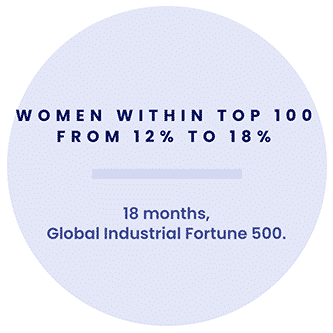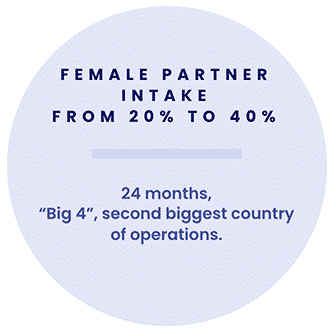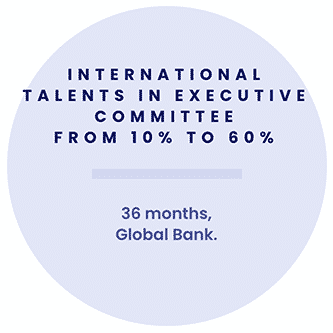The first proven effective solution to reduce unconscious bias
Inclusion Boosters reduce biases by 61%
for a significantly more inclusive work environment
Inclusion Boosters© :
The first program with proven effective,
sustainable behavioral change
Neurovalue’s Inclusion Boosters© Program is the first proven effective program to reduce unconscious bias. Our very first pilots show that the impact of the program impact lasts for at least 4 years.
Inclusion Boosters© is the outcome of 15 years of research in collaboration with eminent university professors. We identified interventions that could potentially to change deeply anchored mental mechanisms. We measured the impact of each of these interventions and selected the most effective ones. We simplified them. We made them fun whenever possible and scalable.
THE INCLUSION BOOSTERs©PROGRAM
INCLUDES THREE STEPS
Step 1
Instigate change
with Neurovalue Implicit
Association Tests
Step 2
Learn
why what and how to change with in-person or online sessions,
or e-learning

Step 3
Practice
new habits over 8 weeks
Step 1
Measure unconscious bias to instigate behavioral change
We cannot change what we do not know.
Explicit, conscious, are similar to implicit, unconscious
attitudes are aligned only for 27% of attitudes. Our tests allow participants to become aware of their unconscious attitudes.
They automatically trigger behavioral change for 80% of test takers.
Each organization develops specific unconscious biases. Identifying and quantifying the specific biases of your organization will allow you to effectively reduce bias by developing the right programs. Individual awareness for the specific unconscious bias prevailing within your organization will effectively instigate individual behavioral change.
implicit association tests
You will select up to 8 themes from our standard list of 16. Test takers will become aware of their unconscious biases, the first step to behavioral change. You will get large scale awareness and quantified reports.
Dashboards
With our dashboards, you will get precise measures of the unconscious bias in your organization. You will be in a better position to closely pilot your diversity and inclusion policy, including for diversity dimensions for which capturing data is impossible or tricky. We can measure biases by demographic dimensions (such as country, nationality, business unit, function, hierarchical level, gender, age…), as long as the sample remains larger than 10 tests from different people to ensure anonymity.
Two options depending of the number of people
Individual accounts
You can buy credits for a few anonymous individual accounts, which are available for 6 months. Each participant will be able to take many tests and measure if his or her biases are stable over the time.
Annual license
Our annual licence is adapted for a large number of participants. They can create their personal anonymous account, take many tests in their account. They will be able to track the evolution of their biases over the time.
tests CustomizatioN, a decisive advantage
Each corporate culture generates specific unconscious biases. Biases are often impacted by your education and your corporate culture. Most of all, they are contagious!
Identify and measure bias specific to your corporate culture and to the competences you seek
We create custom implicit association tests for a range of emotional biases (eg biases that trigger an emotion) or social biases. We have developed a unique approach to identify the unconscious biases prevalent in your organization. As these tests target your organization unique biases, they are highly effective to eliminate or at least reduce them. We can also provide specific personality tests to measure how your personality can amplify or reduce your biases or the noise in your reasoning.
Step 2 :
Learn why what and how to change with in-person or online sessions,
or e-learning
While the vast majority of unconscious bias and D&I trainings have no impact, our training sessions have been scientifically assessed, including in collaboration with Prof. Mahzarin Banaji of Harvard University.
WEBINAR AND IN-PERSON TRAINING UNCONSCIOUS BIAS, DIVERSITY AND INCLUSION
Executive committee seminars and trainings
Executive Committee members manage a diversity of talents. With our one to two and a half hour session, they will be able to understand how our brain impacts our ability to manage differences. They will learn how to modify their day-to-day behaviors to be more open to different points of view and more generally to differences. They will also practice techniques for making more objective talent management decisions.
We also offer face-to-face, one daydaily sessions or several online sessions to learn practical techniques to better manage diversity and become more inclusive.
Training managers and employees
We have developed training modules adapted to our client specific training needs, ranging from 30 minutes to one day.
30 to 60 min modules
Our 30-minute modules are best suited for companies where diversity and inclusion is already advanced. Their goal is to introduce the Inclusion Boosters© program.
Half-day modules
The objective of our half-day sessions is generally to motivate participants to become more inclusive.
They generally include :
- An overview of Systems 1 and 2, and the main concepts of bias,
- Awareness of unconscious biases with tests and practical, fun exercises,
- a presentation of the impacts of well-managed D&I on performance,
- exercises to become more inclusive on a daily basis and know good practices to make more objective decisions.
Step 3
Inclusion Boosters©
Sustainable behavioral change
During 15 years, we conducted research to identify effective, measurable and scalable bias breaking interventions. We identified 8 effective habits to generate long lasting sustainable behavioral change.
Our biases are usually the result of deeply ingrained habits and behaviors, the fruit of our past experiences and the culture in which we live. From the age of 6 months, babies will automatically tend to turn more towards a woman rather than a man. Dr. Banaji from Harvard University has also shown that a baby will automatically tend to turn to an adult who has the same skin color.
We have identified about 50 interventions likely to generate behavioral change. We measured their impact in different environments. We kept the most effective actions. We then selected the actions that were short, fun and easy to implement in a business setting. These actions are integrated into our Booster Program.
The first program that eliminates unconscious bias
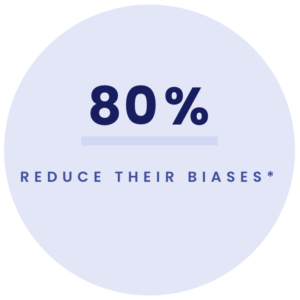
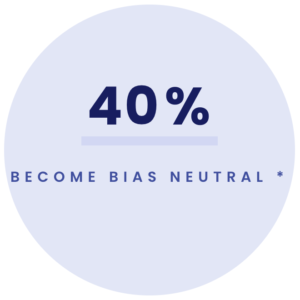
*Based on a sample of 650 leaders across multiple change programs. Results obtained with test results, HR data and controlling data before and after intervention.
A qualitative and quantitative
diversity and inclusion diagnosis
Most organizations struggle to change the composition of their management teams, which often remain male, focused on the same functions and nationalities. At the current pace, it would take 90 years at best for big corporations to achieve gender parity at the top and 217 years for society at large* while in many countries, more than half of university graduates are female.
We carry out a detailed analysis of the obstacles specific to your organization, whether cultural or structural, because each organization is unique.
- We analyze demographic and HR data. In particular, we identify the dropout points of some population groups. We also identify the source of such dropouts. When the representation of women gets lower at some levels, the source of the decline is often at much lower levels, with lower promotion rates or lateral movements. To get a lasting impact, it is therefore necessary to act at the source of the dropout and not at the level where the dropout becomes visible.
- We interview employees and/or deliver quantitative surveys to identify cultural and organizational obstacles to diversity and inclusion, particularly related to work organization.
- We identify the specific unconscious biases prevailing in each organization, and quantify them with standard or custom Cognitive Profiler tests.
- We assess the general impact of HR processes using our assessment grids in recruitment, promotions, retention, etc. We deliver a general prioritization of the actions to implement.
We also provide a detailed view of your ability to leverage a wide range of talents, whether in terms of gender, age, competency, and any other important dimension for your business.
Impact-driven diversity and inclusion policies
Leveraging the results of the qualitative and quantitavtie diagnosis, we deliver one or more workshops with our teams in order to ease of implementation matrix to prioritize actions.
Then, we design woth you a general policy and a specific action plan with actions to implement, their timing, the resources to be allocated, implementation calendar and KPIs to monitor both the implementation of the ations as well as their impact.
Reinventing talent management for objective decisions
Most talent management processes are designed for our rational System 2: they do not effectively control unconscious biases. Many are over-engineered: decision-makers waste significant time. They also often reduce engagement with perceptions of unfair evaluations.
To address such challenges, we first analyze your talent management process and identify how you intuitively assess performance, potential and select talents for promotion.
We then adapt your talent management process to your automatic System 1 and your business drivers. You get an effective process structure, decision-making criteria, discussion documents, tools, and key decision-makers at each stage.
You enhance engagement and best leverage all talents. You gradually increasing gender diversity at the top.
Diversity, inclusion and reduction of unconscious bias have a strong impact of performance
Expectations in terms of diversity and inclusion but also gender equality are substantially increasing, particularly among young talents
The many crises and transformations underway require new talents and skills, and more agile and cooperative teams. Inclusive behaviors become a real competitive advantage
Unconscious biases are a significant impact on diversity, inclusion and cooperative capabilities in business
Unconscious biases also have a direct impact on the quality of work life.
Our impact is quantified :
Don’t wait 217 years for results*
